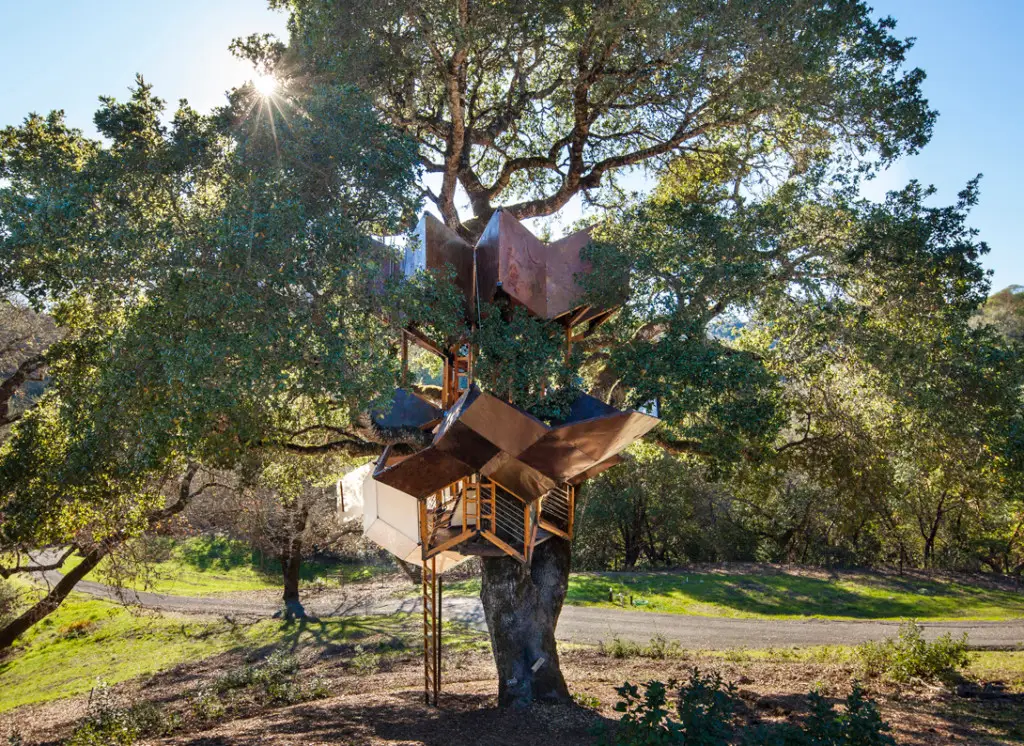Outside Healdsburg, master craftsman Dustin Feider installed this expressionistic prefabricated structure in just a few days.
“I’VE CHANGED THE WAY I used to build,” 33-yearold tree-house-maker Dustin Feider says, indicating a 320-square-foot dwelling he has crafted within a magisterial oak amid 165 hilly acres outside Healdsburg, an hour north of Mill Valley.
His futuristic spaceship-like assemblage includes a starshaped meditation deck made of Douglas fir, a sleeping loft with a floor of sustainably harvested chichipate wood from Argentina, a hammock made of netting and a diaphanous watertight 12-foot-diameter geodesic dome of high-density recyclable polyethylene “milk-carton” plastic, all of which seems to have sprung forth naturally.
It is a bouquet of materials and experiential possibilities for the owner, banker Jeff Baird, his wife and two young daughters, who used the tree house regularly on weekends before their main house was built. The Bairds could barely wait for the structure to be finished before clambering up its ladder to take in expansive views over meadows and woods. When it was completely ready, they spent their first night on the property inside their quirky observatory in the sky.
Feider, a furniture maker at heart, was drawn to his new craft at the Minneapolis College of Art and Design, where as part of his thesis he examined unusual resource-saving tree houses inspired by Buckminster Fuller’s compact geodesic dome. “But I had no idea how to go about building one,” he says, until he attended a conference about tree houses and learned some tricks from actual builders. Without that input, his first structures might have been like fixed furniture, built with bolts, trusses and posts.
Now, with as many as three dozen tree houses behind him, and a lot more experience, “I suspend them using cables so that they can move as easily as the host trees do, without harming them,” Fieder explains. “A tree is also living and needs to move freely and bend along the full length of its branches. If you introduce a fixed point such as an attached tree house, you cut a tree’s flexibility by half, and in extreme wind conditions it can crack.”
According to Feider, deciduous trees move the most, and if structures are suspended within them, they rock gently “like boats in water” when the wind picks up.
“A suspended house is thus more dynamic than a fixed one and allows for directional movement. It also lets tree house inhabitants feel as if they are cradled in a tree,” Feider says.
With the safety both of the tree and of people being paramount, Feider does use bolts when they are essential, but he makes sure that “the large cylindrical plugs of 41/45 steel are only tapped six inches deep into the outer surface of a tree,” he says. “The bolts are thick and will not rust inside or weaken a tree.”
Hanging structures that are prefabricated on the ground or in Oakland at Feider’s O2 Treehouse workshop (so called because trees give us oxygen) are then pulled up on site “like lanterns” and hung between conifers. Priced from $15,000 to $85,000, these prefabricated tree houses are less expensive than conventional ones and can be installed more quickly, within days.
Feider and his small team of experts are now so adept at building their structures in every kind of tree that they “scamper about effortlessly in the air during construction,” Baird marvels.
For several years, Feider worked in Los Angeles, San Diego and even the Southern California desert, until one day it dawned on him that he needed to move closer to the giant redwoods up north, where his suspended structures could be positioned higher than ever before. “Up here, a geodesic structure floating a hundred feet above the ground is not impossible,” he says. “I am looking for a client to share that dream with.”

